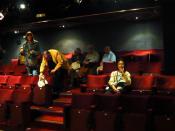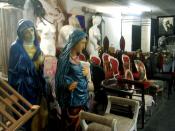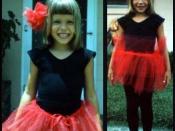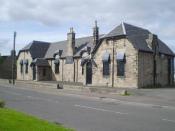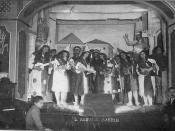About a week ago I went to Theater Schmeater to see the play Bondagers by Sue Glover. In the program there is a short definition as to what a Bondager was: "Bondagers were the women workers of the great Border farms in the last century. Each farm worker was hired on condition he brought a female worker to work alongside him-if not his wife or daughter, then some other girl that he had to hire at the Hiring Fair, and lodge and feed alongside his own family in his tiny cottage."ÃÂ This is when the play takes place: sometime in the last century, and it is set in Scotland. The cast was made up of six women, Bondagers, and as the play goes on we go through the trials and tribulations that a Bondager in the eighteenth century would have had to face over the duration of her stay at a given farm.
Although I thought that the script was lacking in that I had problems finding it in myself to care about the plot and to fully understand what was going on, I thought the acting and the design were both very well done. The lighting and the set itself wonderfully complimented the mood of the play and its location; the costumes were both period and again helped to assist in establishing a certain mood throughout the entirety of the play. In addition the small amount of props and subtle music greatly helped to enhance the show.
When I walked into the theatre there was quite a bit of time before the show, as I sat in my seat I was able to get a fairly good look at the set and tried to get a feel for what the show was going be like. As I looked over the set I got a very cold, lonely feeling. It was constructed of wood planks of all different sizes: the deck itself actually looked like several faded, weather-beaten wooden pallets that were fixed together; coming up out of the deck both stage left and right were two support beams also constructed of wood. As a backdrop, at that time, I could only see one fence-like object that was shabbily built with large gaps between the planks that were not nailed straight on the frame. Later in the show I found that the backdrop was actually two pieces that moved on a track and behind it hung a simple painting that looked something like and abstract landscape. The set stayed the same throughout the entire play; it was quite simple but worked really well. The simplicity of it allowed the actors to play up the loneliness of their roles and the individuality of each character. I feel that if there had been something more elaborate it would have ruined the cold, rainy climate, and hard life that was trying to be created.
To add to that cold, rainy, Scottish climate that the designer was trying to create they made the lighting very simple as well. The lights were kept to whites and pinks, but all very muted or soft whites and pinks. The transitions were very subtle from morning to night, and in doors to out of doors there was very little difference, which made it much more realistic. I personally have spent quite a bit of time in Scotland and it seem that no matter what time of year you are there it is always rainy, bone chilling cold, and gray (much like Seattle) and I think that this lighting choice along with the choice of set design really helped to bring that to life. As soon as the show started everyone knew that this wasn't a happy enjoyable place we were looking in on. As far as lighting changes there were few, but they were significant. In the play there was a mistress who was wearing much brighter clothes then the rest of the characters, whenever she entered the stage the lights went from the softer white to a soft pink color. Another of the lighting changes that occurred where when the women were supposed to be outside the four clip lights upstage would be light which would put light upstage and also would light the painting of the landscape, and whenever they were inside the upstage lights would be taken out.
The costumes of this show were quite interesting; they really helped to show the class of the people wearing them and what society at that time thought of these women. The costumes for the most part were tattered old rags that were all earth tones. The only women who wasn't wearing bland colors and rag-like clothing was the character who was a mistress. She wore very bright, beautiful dresses that completely contrasted from the rest of the cast, set and lights. All of the colors that she wore were some shade of red or had a red base to them, which I think showed class and progression which all of the other women were lacking. And because the women were supposed to be poor the only person in the cast who had a costume change was the mistress. I thought that was very appropriate, if the other women of the cast had several costume changes it would have completely taken away from the continuing theme of poverty and hopelessness.
Continuing with the simplicity of the show there was very little music or sound effects and very few props. When the show opened we could hear the sound of wind blowing and women's voices. And it was not a full-bodied sound, the voices and wind sounded very hallow and distant, as did all of the sound we heard. Throughout the play some music was played but it was one string or note that just repeated itself over and over. I thought that that was a very interesting choice simply because that is not done very often. Usually, what I have found, if there is going to be music and some sort of sound effects then there are many of them, and if not many then the ones we do hear have a lot of power behind them. As far as props go, there were few, there were two or three farm tools, some bundles that were introduced at the beginning of the show that the women carried all of their things in, an apple, a candle and a comb. I think the choice to have only a few props was great because it gave so much importance to the props that were actually there. Several times during the play the characters mimed cooking, sewing, holding a baby, and eating. It was the fact that in addition to having these mimed props that they also had actual tangible things to use that made it so much more interesting, it allowed for so much symbolism and importance to be placed on the props that were "real"ÃÂ.
Overall I thought that the design of the play worked quite well and was very appropriate. All of the technical aspects of the play were subtle enough to not take away from the acting but at the same time they did a wonderful job complimenting the work the actors and director did to put the play together. Personally, I think that this is the first play that I have ever seen that was well done both technically and acting, but at the same time had a bad script. There were definite, understandable, and appropriate themes that were being portrayed through the design. First of all the set and lighting helped greatly in giving the audience the feeling of the cold wet climate of Scotland that these women had to live and work in, this feeling was established during pre-show and was enhanced as the actors came out on stage. They as they came out on stage they talked with authentic Scottish accents, and were wearing costumes that were tattered and torn, and literally wrapped around them. In addition to the type of clothing they were wearing the earth tones that the clothes were colored gave the audience the understanding that these women were poor and that there was a hopelessness about them, which probably could not have been understood without the costumes. Accompanying the actors on stage was the music and props. Again, both of which were subtle but the subtleties of each made it that much more powerful. The hallow sound of women singing, wind blowing a children's laughter gave the play a very eerie, lonely feel, and the miming of certain items on stage helped to show us how little these women actually had and placed importance of the items that weren't mimed. In the end everything was successfully tied together with the sounds we heard at the opening of the play.
